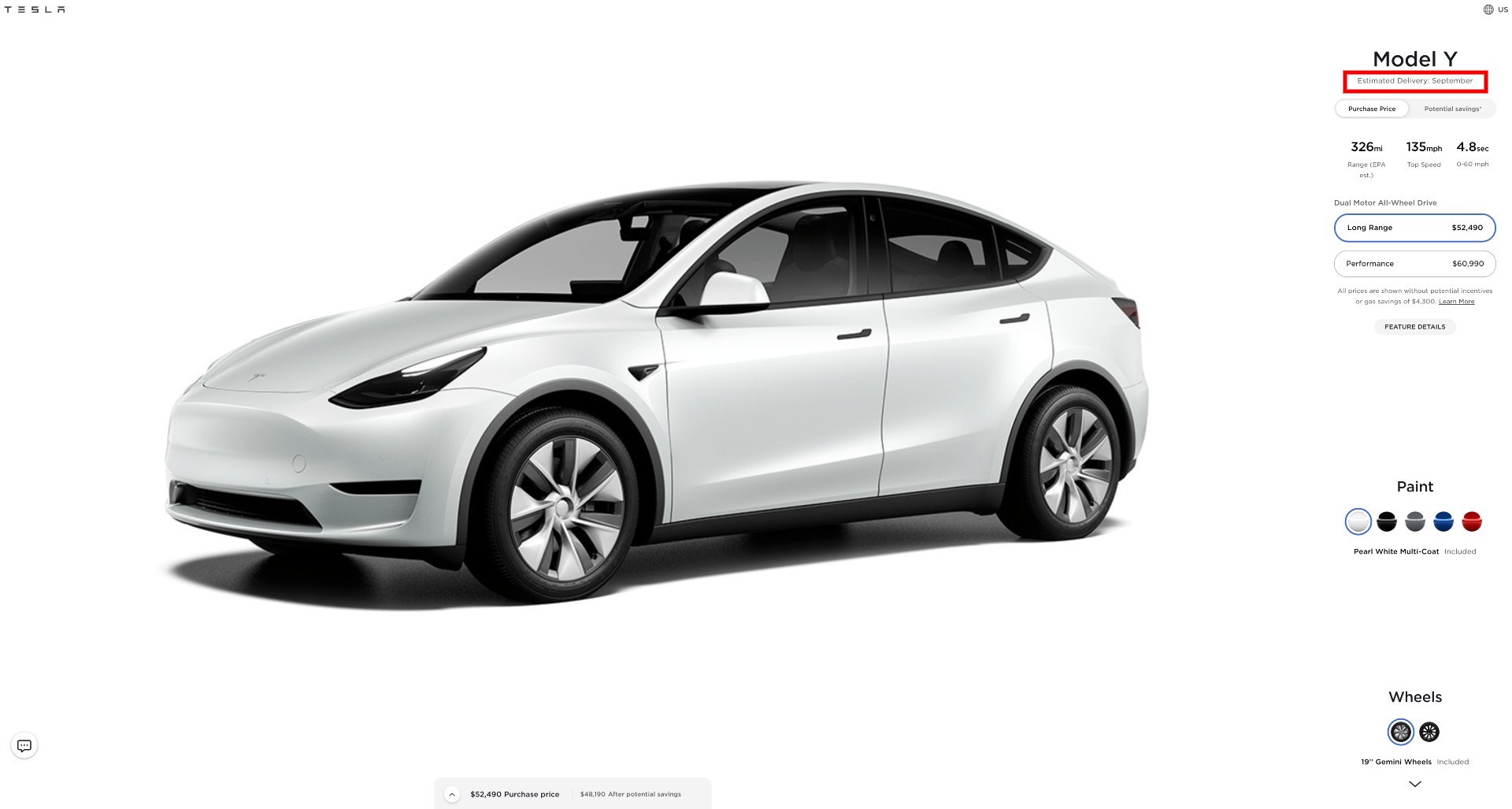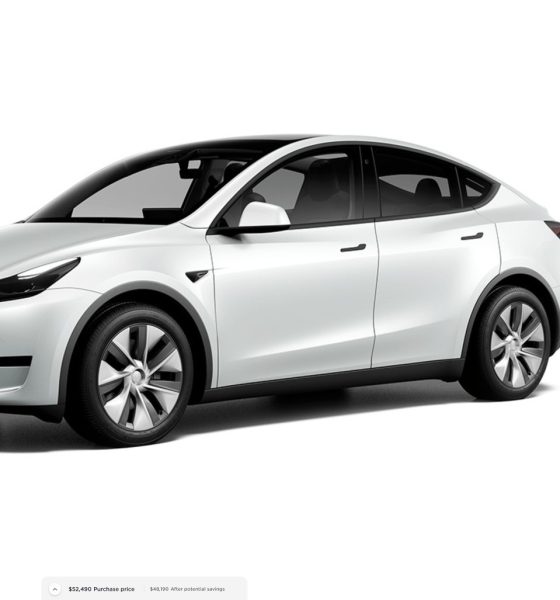The demand for the Tesla Model Y Long Range variant is skyrocketing as the company now outlines the soonest possible date to take delivery in September, meaning the vehicle is nearly sold out in Q3, even though it is still Q2.
After releasing the all-electric crossover last year, Tesla CEO Elon Musk predicted that the Model Y would overtake the Model 3 in terms of popularity. In several markets, like China and more locally in California, the Model Y has already established itself as the overachieving little brother because people are tending to buy the all-electric crossover more than the all-electric sedan.
As Tesla continues to ramp up its manufacturing efforts for all of its vehicles, the Model Y is the main focus of the automaker as it expands into new regions. In Austin at Giga Texas, the Model Y and the Cybertruck will take center stage when the facility begins manufacturing the vehicles by the end of 2021. This plan is reflected with the Model Y in Europe, where Tesla’s first Gigafactory on the continent in Germany will manufacture the Model Y straight out of the gate later this year.
However, demand is becoming a bit overwhelming for Tesla as it aims to complete two new factories by the end of 2021. The company’s cars are becoming so popular in so many regions that delivery dates are becoming more prolonged, meaning the need for additional production facilities is becoming more apparent as the transition to sustainable energy continues to leap forward.
It was hinted in early May that Tesla had already sold out of Q2 production volume because of increasing demand. While that is still an amazing accomplishment, Tesla is already starting to sell out for the next quarter with at least one of its cars. The Model Y Long Range is proving to be Tesla’s biggest seller, it appears, as the company is estimating the earliest delivery date will be September, the final month of 2021’s Q3.

Credit: Tesla
The demand has led to Tesla increasing the prices of the Model Y by $3,500 so far this year, after cutting the cost of the car significantly in February. Tesla has avoided encountering severe problems due to the global chip shortage. Still, demand and some parts shortages have resulted in Tesla hiking the prices of its two mass-market vehicles in 2021.
Tesla has made several changes to the Model Y this year, including removing a lumbar-support option in the passenger’s seat. One of the biggest changes, however, is Tesla’s removal of radar equipment in the Y and the 3, a move that Tesla has long considered in its quest for Full Self-Driving.
Nevertheless, the demand for the Model Y is skyrocketing based on recent registration figures. The Model Y overtook the Model 3 in April, according to the EV Sales Blog’s Global sales figures. It sold 16,232 units compared to the Model 3’s 14,980. The Model 3 retained the title of most popular EV in 2021, but the Model Y sits in third, just behind the Wuling HongGuang Mini EV from the GM-SAIC-Wuling venture in China.
CEO Elon Musk predicted earlier this year that the Model Y would be the best-selling vehicle globally in 2022. “When it comes to Model Y, we think Model Y will be the best-selling car or vehicle of any kind in the world and probably next year,” he said during the Q1 2021 Earnings Call. “So I’m not 100% certain next year, but I think it’s quite likely. I’d say more likely than not that in 2022, Model Y is the best-selling car or truck of any kind in the world.”
The Model Y was the first vehicle in Tesla history to be profitable in its first quarter of production. The demand for the Model Y and its evident growth through sales figures from various outlets bodes well for Tesla’s financials. The company will aim for its eighth-consecutive profitable quarter when it reports its earnings sometime next month.

Elon Musk
Elon Musk and Tesla AI Director share insights after empty driver seat Robotaxi rides
The executives’ unoccupied tests hint at the rapid progress of Tesla’s unsupervised Robotaxi efforts.

Tesla CEO Elon Musk and AI Director Ashok Elluswamy celebrated Christmas Eve by sharing personal experiences with Robotaxi vehicles that had no safety monitor or occupant in the driver’s seat. Musk described the system’s “perfect driving” around Austin, while Elluswamy posted video from the back seat, calling it “an amazing experience.”
The executives’ unoccupied tests hint at the rapid progress of Tesla’s unsupervised Robotaxi efforts.
Elon and Ashok’s firsthand Robotaxi insights
Prior to Musk and the Tesla AI Director’s posts, sightings of unmanned Teslas navigating public roads were widely shared on social media. One such vehicle was spotted in Austin, Texas, which Elon Musk acknowleged by stating that “Testing is underway with no occupants in the car.”
Based on his Christmas Eve post, Musk seemed to have tested an unmanned Tesla himself. “A Tesla with no safety monitor in the car and me sitting in the passenger seat took me all around Austin on Sunday with perfect driving,” Musk wrote in his post.
Elluswamy responded with a 2-minute video showing himself in the rear of an unmanned Tesla. The video featured the vehicle’s empty front seats, as well as its smooth handling through real-world traffic. He captioned his video with the words, “It’s an amazing experience!”
Towards Unsupervised operations
During an xAI Hackathon earlier this month, Elon Musk mentioned that Tesla owed be removing Safety Monitors from its Robotaxis in Austin in just three weeks. “Unsupervised is pretty much solved at this point. So there will be Tesla Robotaxis operating in Austin with no one in them. Not even anyone in the passenger seat in about three weeks,” he said. Musk echoed similar estimates at the 2025 Annual Shareholder Meeting and the Q3 2025 earnings call.
Considering the insights that were posted Musk and Elluswamy, it does appear that Tesla is working hard towards operating its Robotaxis with no safety monitors. This is quite impressive considering that the service was launched just earlier this year.
Elon Musk
Starlink passes 9 million active customers just weeks after hitting 8 million
The milestone highlights the accelerating growth of Starlink, which has now been adding over 20,000 new users per day.

SpaceX’s Starlink satellite internet service has continued its rapid global expansion, surpassing 9 million active customers just weeks after crossing the 8 million mark.
The milestone highlights the accelerating growth of Starlink, which has now been adding over 20,000 new users per day.
9 million customers
In a post on X, SpaceX stated that Starlink now serves over 9 million active users across 155 countries, territories, and markets. The company reached 8 million customers in early November, meaning it added roughly 1 million subscribers in under seven weeks, or about 21,275 new users on average per day.
“Starlink is connecting more than 9M active customers with high-speed internet across 155 countries, territories, and many other markets,” Starlink wrote in a post on its official X account. SpaceX President Gwynne Shotwell also celebrated the milestone on X. “A huge thank you to all of our customers and congrats to the Starlink team for such an incredible product,” she wrote.
That growth rate reflects both rising demand for broadband in underserved regions and Starlink’s expanding satellite constellation, which now includes more than 9,000 low-Earth-orbit satellites designed to deliver high-speed, low-latency internet worldwide.
Starlink’s momentum
Starlink’s momentum has been building up. SpaceX reported 4.6 million Starlink customers in December 2024, followed by 7 million by August 2025, and 8 million customers in November. Independent data also suggests Starlink usage is rising sharply, with Cloudflare reporting that global web traffic from Starlink users more than doubled in 2025, as noted in an Insider report.
Starlink’s momentum is increasingly tied to SpaceX’s broader financial outlook. Elon Musk has said the satellite network is “by far” the company’s largest revenue driver, and reports suggest SpaceX may be positioning itself for an initial public offering as soon as next year, with valuations estimated as high as $1.5 trillion. Musk has also suggested in the past that Starlink could have its own IPO in the future.
News
NVIDIA Director of Robotics: Tesla FSD v14 is the first AI to pass the “Physical Turing Test”
After testing FSD v14, Fan stated that his experience with FSD felt magical at first, but it soon started to feel like a routine.

NVIDIA Director of Robotics Jim Fan has praised Tesla’s Full Self-Driving (Supervised) v14 as the first AI to pass what he described as a “Physical Turing Test.”
After testing FSD v14, Fan stated that his experience with FSD felt magical at first, but it soon started to feel like a routine. And just like smartphones today, removing it now would “actively hurt.”
Jim Fan’s hands-on FSD v14 impressions
Fan, a leading researcher in embodied AI who is currently solving Physical AI at NVIDIA and spearheading the company’s Project GR00T initiative, noted that he actually was late to the Tesla game. He was, however, one of the first to try out FSD v14.
“I was very late to own a Tesla but among the earliest to try out FSD v14. It’s perhaps the first time I experience an AI that passes the Physical Turing Test: after a long day at work, you press a button, lay back, and couldn’t tell if a neural net or a human drove you home,” Fan wrote in a post on X.
Fan added: “Despite knowing exactly how robot learning works, I still find it magical watching the steering wheel turn by itself. First it feels surreal, next it becomes routine. Then, like the smartphone, taking it away actively hurts. This is how humanity gets rewired and glued to god-like technologies.”
The Physical Turing Test
The original Turing Test was conceived by Alan Turing in 1950, and it was aimed at determining if a machine could exhibit behavior that is equivalent to or indistinguishable from a human. By focusing on text-based conversations, the original Turing Test set a high bar for natural language processing and machine learning.
This test has been passed by today’s large language models. However, the capability to converse in a humanlike manner is a completely different challenge from performing real-world problem-solving or physical interactions. Thus, Fan introduced the Physical Turing Test, which challenges AI systems to demonstrate intelligence through physical actions.
Based on Fan’s comments, Tesla has demonstrated these intelligent physical actions with FSD v14. Elon Musk agreed with the NVIDIA executive, stating in a post on X that with FSD v14, “you can sense the sentience maturing.” Musk also praised Tesla AI, calling it the best “real-world AI” today.










